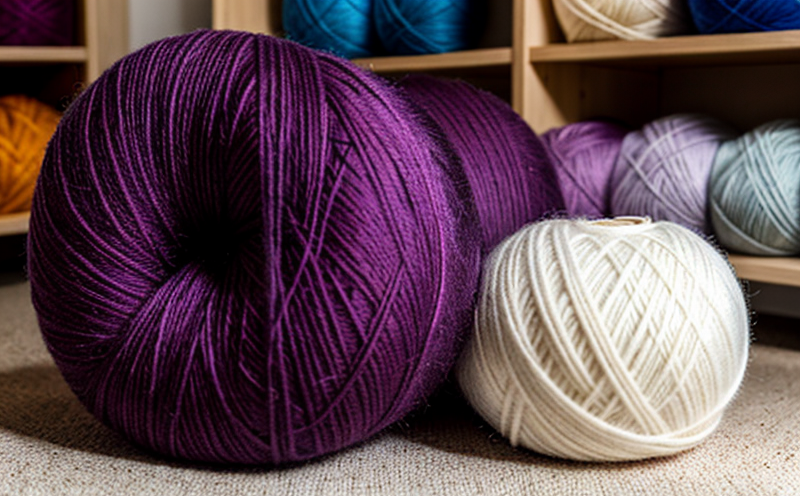JIS L1100 Methods for Testing Yarn Hairiness and Evenness
The JIS L1100 series of standards provides methods for evaluating yarn hairiness and evenness, which are critical parameters in the textile industry. These tests help ensure that textiles meet quality standards and customer expectations. Hairiness refers to the length and density of fibers protruding from a yarn surface, while evenness describes the uniformity of these properties along the yarn's length.
The importance of hairiness and evenness cannot be overstated as they directly influence the performance, appearance, and feel of textile products. A well-controlled level of hairiness can enhance the softness of fabrics, making them more comfortable to wear. Conversely, excessive or uneven hairiness may lead to issues such as snagging, pilling, or poor drape.
The JIS L1100 methods are widely used in quality control processes, research and development activities, and compliance checks for yarn production facilities. These tests provide a standardized approach to measuring the physical characteristics of yarns, ensuring consistency across different batches and suppliers.
Testing according to JIS L1100 involves several steps: preparation of test samples, measurement using specialized instrumentation such as the Yarn Hairiness Tester (YHT), and interpretation of results based on industry standards. The process begins with selecting appropriate specimens from raw materials or finished products. Specimens must be prepared carefully to avoid altering their inherent properties.
The primary tool used in these tests is the YHT, which measures hairiness by counting protruding fibers within a defined area. Hairiness values are reported as the average count per unit length. Evenness is assessed through visual inspection and comparison with reference samples or established thresholds.
Accurate measurement of yarn hairiness and evenness requires precise instrumentation and skilled operators. Operators must undergo training to ensure consistent results across multiple tests. Regular calibration of equipment ensures accurate measurements, which in turn supports reliable quality assessment.
The JIS L1100 methods are essential for maintaining high standards within the textile industry. By providing a standardized approach to measuring yarn hairiness and evenness, these tests enable manufacturers to produce consistent products that meet customer expectations. They also facilitate continuous improvement efforts by identifying areas where process adjustments can enhance product quality.
Compliance with JIS L1100 standards is crucial for companies operating in global markets. Adhering to international norms ensures compatibility with international buyers and reduces the risk of non-compliance penalties. Moreover, compliance fosters trust among stakeholders, including suppliers, customers, and regulatory bodies.
In summary, testing yarn hairiness and evenness according to JIS L1100 is vital for maintaining quality control in textile manufacturing processes. These tests provide valuable insights into the physical characteristics of yarns, enabling manufacturers to optimize production methods and meet stringent industry standards.
Why It Matters
The significance of hairiness and evenness cannot be overlooked as they significantly impact the performance, appearance, and feel of textile products. Hairiness refers to the length and density of fibers protruding from a yarn's surface, while evenness describes the uniformity of these properties along its length.
- Enhanced Softness: Properly controlled hairiness can improve fabric softness, making it more comfortable for end-users.
- Aesthetic Appeal: Consistent evenness contributes to an aesthetically pleasing appearance, enhancing overall product appeal.
- Improved Durability: Balanced hairiness and evenness contribute to greater durability, reducing the likelihood of snagging or pilling during wear.
- Better Drape: Evenly distributed fibers result in better drape, which is crucial for achieving desired garment shapes.
- Purchaser Confidence: Compliance with international standards like JIS L1100 boosts confidence among buyers and ensures product quality.
These factors collectively underscore the importance of thorough testing according to JIS L1100 guidelines. By ensuring that yarn hairiness and evenness meet specified criteria, manufacturers can produce high-quality textiles that satisfy both technical requirements and customer expectations.
Scope and Methodology
The scope of the JIS L1100 series includes methods for evaluating yarn hairiness using the Yarn Hairiness Tester (YHT) and assessing evenness through visual inspection. The tests are applicable to various types of yarns, including synthetic, natural fibers, and blends.
For hairiness testing with the YHT, a specific length of yarn is cut into specimen pieces. These specimens are then placed in the instrument's measurement area. The device counts protruding fibers within predefined limits, providing an average count per unit length as the result.
Evenness evaluation involves visually comparing test samples against reference standards or established thresholds. This subjective assessment requires trained personnel to ensure consistency and accuracy. Both hairiness and evenness tests are crucial for achieving consistent quality in textile products.
The methodology outlined in JIS L1100 ensures that all measurements are conducted under controlled conditions, minimizing variability due to external factors. Regular calibration of the YHT and other testing equipment further enhances reliability. Compliance with these standards helps manufacturers produce textiles that meet international quality benchmarks.
Use Cases and Application Examples
- Quality Control: Continuous monitoring of yarn hairiness and evenness ensures consistent product quality across production batches.
- Research and Development: Testing according to JIS L1100 aids in identifying optimal fiber blends and processing techniques for improved performance.
- Purchasing Decisions: Suppliers use these tests to verify that raw materials meet specified standards before incorporation into final products.
- Compliance Verification: Compliance officers rely on JIS L1100 methods to ensure adherence to international standards and avoid potential penalties.
In addition, these tests are integral in addressing specific challenges faced by the textile industry. For instance, manufacturers can use hairiness and evenness data to address issues like pilling or poor drape, which could otherwise lead to customer dissatisfaction. By leveraging JIS L1100 methods effectively, companies can enhance their competitive edge in the market.





